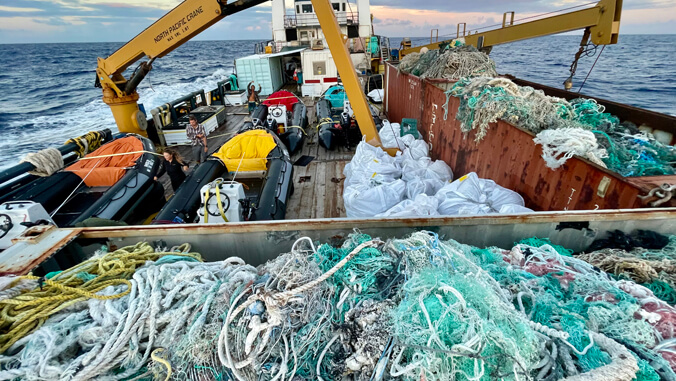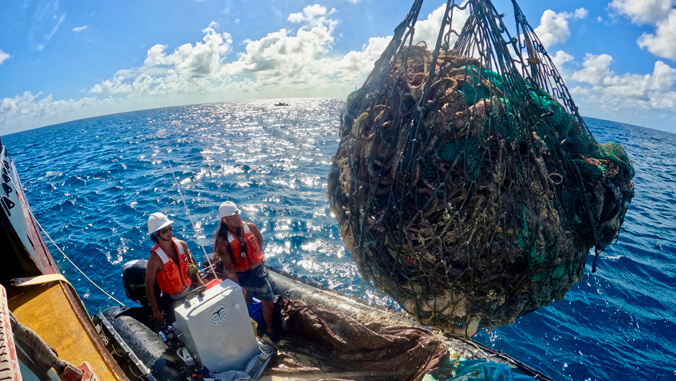
Nearly 100,000 pounds of marine debris that was smothering coral reefs and beaches in the Northwestern Hawaiian islands has been removed, thanks to a group that included University of Hawaiʻi at Mānoa alumni and students.
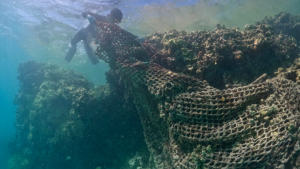
Sixteen free divers from the non-profit organization Papahānaumokuākea Marine Debris Project (PMDP) collected 97,295 pounds of marine debris from Papahānaumokuākea Marine National Monument over a 27-day mission in July. More than 88% of that, or 86,000 pounds, consisted of ghost nets cleared from a single reef. Nine of the 16 team members were either UH Mānoa alumni and/or current students at UH Mānoa and UH Hilo.
“The fact that we are seeing this kind of accumulation in such a single small area is really indicative of the scale of the global marine debris issue,” said Kevin O’Brien, PMDP president and founder, and 2006 UH Mānoa zoology graduate.
A majority of the debris collected will be incinerated to generate electricity to power hundreds of Oʻahu homes, according to PMDP. In addition, some of the recyclable plastics will be set aside for PMDP’s local student-led ocean plastics recycling project.
Dangers of ghost nets
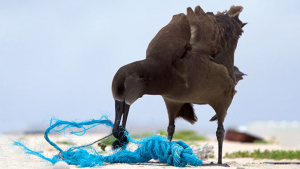
Ghost nets are large, tangled masses of lost or discarded fishing nets made of plastic. They can snag on the shallow coral reefs, smothering and breaking the living coral colonies. These nets also pose a hazard for most marine wildlife, including honu (Hawaiian green sea turtles), many species of seabirds and the endangered Hawaiian monk seal.
The reef where the ghost nets were removed is known as Kamokuokamohoaliʻi (island of the shark god) or Maro Reef. It is one of the most diverse coral reefs in Hawaiʻi, harboring 37 coral species. Kamokuokamohoaliʻi lies in the heart of Papahānaumokuākea Marine National Monument, a string of remote and uninhabited islands that make up the last 1,300 miles of the Hawaiian island chain. The shallow portion of the reef (depth of less than 10 feet) that marine debris accumulated on is roughly eight miles long. It supports a vibrant ecosystem, including Hawaiian monk seals, honu, rays, sharks and thousands of reef fish, many of them found only in Hawaiʻi.
O’Brien described the amount of ghost nets removed from the reef as equivalent to taking a walk through Central Park and a few surrounding blocks, and finding trash equal to the weight of a commercial airliner.
Locating ghost nets
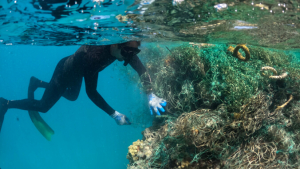
Divers swim in patterns over the reef to search for the nets. When a net is located, the divers carefully cut the net free from the reef to avoid further damage and haul them by hand into a boat. Nets vary in size, but may weigh upwards of 2,000 pounds each. All removal work is completed using breath-hold diving techniques to keep the team quick and nimble.
Other marine debris
In addition to the 86,000 pounds of ghost nets collected, PMDP also cleaned up an additional 11,000 pounds of nets and plastics from the shorelines of two other locations: Kamole (Laysan Island) and Kapou (Lisianski Island).
An estimated 115,000 pounds of marine debris accumulates annually on Papahānaumokuākea reefs, according to PMDP Executive Director James Morioka, who is a 2012 UH Mānoa graduate in marine biology. PMDP’s next clean-up mission is planned for September, with the goal of removing another 100,000 pounds of debris.
“It’s our goal at PMDP to continue regular clean-up efforts into the future to maintain coral reef health and protect countless animals from entanglement and potential injury or death,” Morioka said.
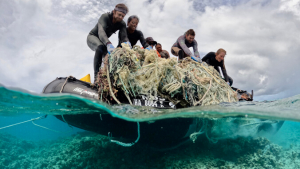
Other PMDP team members with UH ties:
- Derek LeVault—UH Mānoa, 2006, BA zoology
- Kaʻehukai Grant Goin—UH Mānoa, 2021, BA Hawaiian studies; currently pursuing a MS in tropical conservation biology and environmental sciences at UH Hilo
- Maximiliano Lee—UH Mānoa, 2020, BS marine biology
- Sydney Luitgaarden—UH Mānoa, 2019, BS marine biology
- Louise Currie—UH Mānoa, 2017, BS marine biology
- Nāmele Naipo-Arsiga—UH Mānoa, 2017, BS kinesiology and rehabilitation science
- Charlotte Frank—currently enrolled at UH Mānoa in the Graduate Ocean Policy Certificate program in the College of Social Sciences
